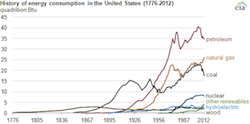Tomorrow is Independence Day, or Fourth of July, for the United States and this week the U.S. Energy Information Administration’s “Today in Energy” brief took a look at how U.S. energy consumption by fuel source has changed since 1776.
 The brief notes that the country started off with renewable energy playing a dominant role in the U.S. energy picture as wood was the primary energy source during America’s first 100 years.
The brief notes that the country started off with renewable energy playing a dominant role in the U.S. energy picture as wood was the primary energy source during America’s first 100 years.
“A typical American family from the time our country was founded used wood (a renewable energy source) as its primary energy source until the mid- to late-1800s. Early industrial growth was powered by water mills. Coal became dominant in the late 19th century before being overtaken by petroleum products in the middle of the last century, a time when natural gas usage also rose quickly.”
The brief notes that while the overall energy history of the United States is one of significant change as new forms of energy were developed, the three major fossil fuels—petroleum, natural gas, and coal, which together provided 87 percent of total U.S. primary energy over the past decade—have dominated the U.S. fuel mix for well over 100 years. However, recent increases in the domestic production of petroleum liquids and natural gas have prompted shifts between the uses of fossil fuels (largely from coal-fired to natural gas-fired power generation), but the predominance of these three energy sources is likely to continue into the future.

